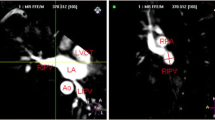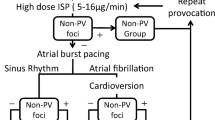Abstract
Background: The pulmonary veins (PVs) have been shown to trigger paroxysmal atrial fibrillation. The relationship of anatomical dimensions versus arrhythmogenicity has not been assessed.
Methods: The diameters of four PVs were measured by selective PV angiography before ablation in 39 consecutive patients (23 male, mean age 46 years) with only one (25 patients) or two (14 patients) arrhythmogenic PVs (ArPVs). After ablation of ArPVs, no patient had recurrence of atrial fibrillation from the remaining PVs. Comparisons were performed variously between ArPV and non-ArPV, and within and across both groups.
Results: ArPVs were distributed as follows; left superior PV: 40%, left inferior PV: 28%, right superior PV: 26%, and right inferior PV: 6%. Statistical comparisons showed that (1) Triggers of atrial fibrillation were located in the largest PV in 72% of patients, (2) For each PV, the mean diameter of ArPV was significantly larger than that of non-ArPV (p < 0.05), (3) No significant difference was observed in the diameter of the four different ArPVs (range 16.2 ± 1.3 to 17.2 ± 4.4).
Conclusions: In patients with atrial fibrillation initiated from one or two ArPVs, the diameters of ArPVs were significantly larger than those of non-ArPVs irrespective of the specific PV concerned, which might imply a possible role of PV dilatation in the arrhythmogenesis.
Similar content being viewed by others
References
Prystowsky EN, Benson DW, Fuster V. Management of patients with atrial fibrillation: a statement for healthcare professionals from the subcommittee on electrocardiography and electrophysiology, American Heart Association. Circulation 1996;93:1262–1277.
Haines DE, McRury IA. Linear atrial ablation in a canine model of chronic atrial fibrillation. Circulation 1997;96:2715–2721.
Gaïta F, Riccardi R, Calo L, et al. Atrial mapping and radiofrequency catheter ablation in patients with idiopathic atrial fibrillation. Circulation 1998;97: 2136–2145.
Calkins H, Hall J, Ellenbogen K, et al. A new system for catheter ablation of atrial fibrillation. Am J Cardiol 1999;83(Suppl):227D–236D.
Ernst S, Schlüter M, Ouyang F, et al. Modification of the substrate for maintenance of idiopathic human atrial fibrillation. Circulation 1999;100:2085–2092.
Haïssaguerre M, Jaïs P, Shah DC, et al. Spontaneous initiation of atrial fibrillation by ectopic beats originating in the pulmonary veins. N Engl J Med 1998;339:659–666.
Jaïs P, Shah DC, Haïssaguerre M, et al. Catheter ablation for atrial fibrillation. Annu Rev Med 2000;51: 431–441.
Hwang D, Karagueuzian HS, Chen PS. Idiopathic paroxysmal atrial fibrillation induced by a focal discharge mechanism in the left superior pulmonary vein: possible role of the ligament of Marshall. J Cardiovasc Electrophysiol 1999;10:636–648.
Lau CP, Tse HF, Ayers GM. Defibrillation-guided radiofrequency ablation of atrial fibrillation secondary to an atrial focus. J Am Coll Cardiol 1999;33:1217–1226.
Rajagopalan B, Bertram CD, Stallard T, et al. Blood flow in pulmonary veins, III: Simultaneous measurements of their dimensions, intravascular pressure, and flow. Cardiovasc Res 1979;13:684–692.
Sivaram CA, Asirvatham S, Sebastian C, et al. Pulmonary venous dilatation in atrial fibrillation. PACE 1999;22:767 (abstract).
Lin W-S, Prakash VS, Tai C-T, et al. Pulmonary vein morphology in patients with paroxysmal atrial fibrillation initiated by ectopic beats originating from the pulmonary veins: implications for catheter ablation. Circulation 2000;101:1274–1281.
Tsao H-M, Yu W-C, Cheng H-C, et al. Pulmonary vein dilation in patients with atrial fibrillation: detection by magnetic resonance imaging. J Cardiovasc Electrophysiol 2001;12:809–813.
Nathan H, Eliakim M. The junction between the left atrium and the pulmonary veins: an anatomic study of human hearts. Circulation 1966;34:412–422.
Yamane T, Shah DC, Hocini M, et al. Pulmonary vein aneurysm in association with arrhythmogenic foci in a patient with focally initiated atrial fibrillation. J Cardiovasc Electrophysiol 2000;11:715.
Author information
Authors and Affiliations
Corresponding author
Rights and permissions
About this article
Cite this article
Yamane, T., Shah, D.C., Jaïs, P. et al. Dilatation as a Marker of Pulmonary Veins Initiating Atrial Fibrillation. J Interv Card Electrophysiol 6, 245–249 (2002). https://doi.org/10.1023/A:1019561820830
Issue Date:
DOI: https://doi.org/10.1023/A:1019561820830




